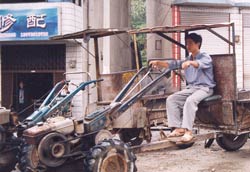Seeds of progress in Chinese agriculture
May / June 2011 | Volume 10, Issue 3

Photo courtesy of Dr. Huiyan Xiang
Injuries have mushroomed among Chinese farm
workers with the advent of heavy equipment and
the departure of able-bodied workers to the cities.
The bucolic nature of farming masks a harsh byproduct: farmers get hurt, sometimes very badly. In China, 700 million farms are worked mainly by the youngest and oldest residents of rural communities, as the 20- to 40-year-olds have migrated to urban areas seeking higher wage employment. Injuries ranging from back pain to deep cuts, contusions, broken and even lost limbs have become epidemic among the so-called "left behind" population - especially as heavy machinery replaces hand tools.
A 2004 epidemiologic study of 200,000 farm families in rural China yielded an annual estimate of more than 590,000 injury deaths and close to 3.5 million permanently disabled individuals. The problem is heightened because trauma care systems are not as advanced in China as in other developing nations.
Slowly, change is coming to the country once known as the Middle Kingdom. Beginning in 2007, Fogarty’s TRAUMA program funded the USA-China Agricultural Research Training Project to provide training to Chinese researchers on issues critical for reducing agricultural injuries and to expand collaborative activities between Chinese injury control research centers and researchers.
More than 80 mid-level and senior researchers have been trained since the program began. Additionally, the project has hosted seven Chinese researchers at the collaborating U.S. institutions: the Colorado Injury Control Research Center and the Center for Injury Research and Policy at Nationwide Children’s Hospital in Ohio.
The Fogarty trainees have published studies on various risk factors of agricultural injuries related to alcohol consumption, sleep patterns, number of pesticide applications and others. They have also investigated other trauma topics including adolescent drowning deaths and child pedestrian injuries. One study of hospital admissions among children found that four percent were pedestrians hit by cars - a number that is rising.
Dr. Loran Stallones, director of the Colorado center, said a number of researchers trained through the program have gone back to China and created injury research programs in their own institutions. "As we were doing the training, it became clear that while people were interested in agricultural injury, they were also interested in pursuing the broader subject of injury training," Stallones said.
One trainee, Xujun Zhang, founded a new injury center called the Southeast University Injury Prevention Institute in Nanjing. Stallones and her fellow principal investigator, Dr. Huiyun Xiang of Nationwide Children’s Hospital, are both serving on the faculty of the new center. Stallones also said an annual injury conference has been established in China, which will assist networking and growth of sustainable research programs.
"The opportunity to do this kind of work is only available through Fogarty," Stallones said. "When you really want to partner with an international entity, it’s very difficult to do through any other source."
As part of their capacity building, the project has also offered training sessions in human research ethics and trainees have set up their own institutional review board. The project has also facilitated the publication of Chinese scholarship into English-language journals so the authors are recognized as active researchers.
Long-term goals include reduction in the number of injuries and better planning for the changing training needs as agriculture evolves from small plots and hand tools to larger-scale, mechanized production. Another goal is to create a network of researchers who are constantly in touch with each other and apprised of the latest publications in agricultural injury prevention.
A trainee from Tongji, Dr. Junxin Shi, said the project "plants numerous research seeds in China. It also builds a friendship bridge between China and the U.S.A." From these seeds, it is expected a large network of injury research will grow.
More Information
To view Adobe PDF files,
download current, free accessible plug-ins from Adobe's website.
Related Fogarty Programs
Related Global Health Research Topics